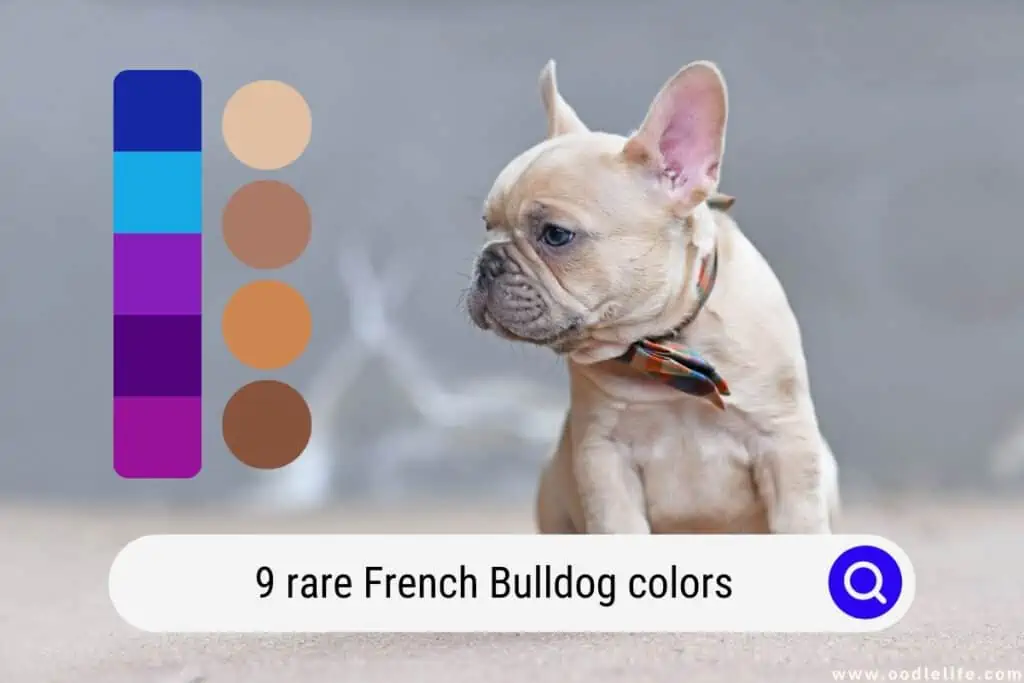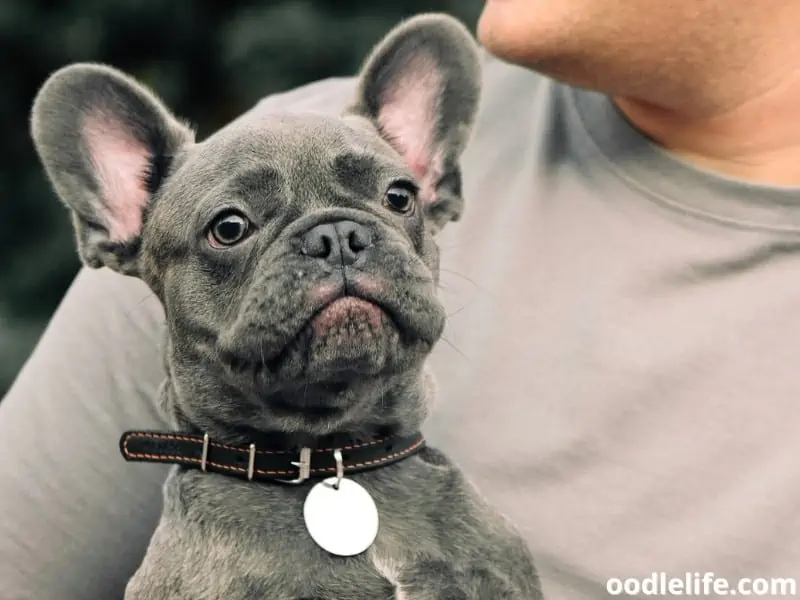9 RARE French Bulldog Colors (Photos)
French Bulldogs are playful and affectionate creatures that come in several colors. The rare Frenchie colors include pure black, sable, black and tan, black and white, blue, blue and fawn, chocolate, lilac, merle, and Isabella.
Blue and Merle French Bulldogs are two of the rarest colored Frenchies, but this means they may have various health troubles. This holds true, especially for blue French Bulldogs.

Another downside is that competitions and pet shows prohibit Frenchies with uncommon hues from entering, as they do not meet the AKC breed standard issued in 1897. The AKC accepts only nine combinations of white, cream, fawn, and brindle-colored Frenchies.
So although you may want to get an unusual colored French Bulldog, you should be aware of the risks and take the necessary measures. Ensure you get your pet only from a reputable breeder, learn about their bloodline, and confirm that they are health tested.
Remember to take your special little Frenchie to the vet regularly after you get it home because these dogs are generally predisposed to health problems.
French Bulldogs
Despite what their name suggests, French Bulldogs aren’t actually French. They originated in England and were quite popular among the Parisians. They later got their trademark “bat ears” when the Americans bred them.
Do you know French Bulldogs were originally called Boule Dog Francais? The English found it offensive to call a British dog by a French name and changed it to its current form.
French Bulldogs are small dogs and are about 13 to 15 inches tall. They have a large, square-like head with heavy wrinkles above their short nose. They have short, smooth coats and make for excellent lap dogs.

Color Variations in French Bulldogs
The French Bulldog’s coat can have various color variations. Some are more common than others. Frenchies are now available in over 25 coat variations and combinations of different colors and markings.
The colors range from black, fawn, and tan to even blue, cream, and white. Hence puppies of this breed often appear unique, and of course, they are attractive.
Standard Colors in French Bulldogs
The American Kennel Club recognizes nine colors as standard colors for French Bulldogs. These are:
- Brindle
- Brindle and White
- Cream
- Fawn
- Fawn and White
- White
- White and Brindle
- Fawn Brindle and White
- White and Fawn
The AKC also recognizes six types of markings:
- Ticked markings
- White markings
- Black markings
- Black mask
- Piebald pattern
- Brindle markings
A different color or marking doesn’t make your dog any less of a French Bulldog. It’s just that you can’t present it at any competitions.

Rare French Bulldog Colors
Out of the 25 different French Bulldog color variations, nine are standard and very popular. But not all of the others are rare.
Here’s a list of 9 + 1 (Bonus) extremely rare Frenchie colors.
1. Pure Black
Pure Black French Bulldogs have a uniform jet black coat without any markings. Reverse Brindle, another type of Frenchie, is often confused for being Pure Black, but it is different. While in Reverse Brindle, the dark strips are so thick that they almost look black, Pure Blacks have no trace of Brindle.
The black color in Pure Black Frenchies is so dominant that when used for breeding, it eliminates all other colors. Yet, they are one of the rarest types of French Bulldogs.

2. Sable
At first glance, one might easily confuse a Sable for a Fawn. But on closer inspection, they will realize that Sables have a unique reddish hue to their fawn base. They even have black tips on their hair that give them a washed-tip look.
Sables can sometimes have black masks or white markings on their chest, just like their fawn counterparts.
The coat of a Sable can vary from lighter tones to darker ones. Sables with blue tips instead of black are even rarer to find.

3. Black and Tan
These are black Frenchies that have inherited tan point genes. They have pure black fur with patches or spots of tan, giving them the look of a mini Rottweiler. These patches are called tan points and can vary from cream to reddish hues.
They can appear on the dog’s face, chest, or legs.
This combination may seem common among other dog species, but it’s very rare among French Bulldogs.

4. Black and White
Like Black and Tan French Bulldogs, these are also black Frenchies with white markings instead of tan. These markings result from the Piebald gene they inherited from their parents. The placement of the markings depends on the genes they inherited, but you’ll usually see them on the chest, face, and paws of the Frenchie.
Black and White French Bulldogs may seem classic, but certain health issues often accompany this rare coat pattern. We will discuss this in detail later in the article.

5. Blue
Blue French Bulldogs are definitely among the rarer types of bulldogs, if not the rarest. There’s often a long waitlist for them, and people don’t shy away from paying extra.
Blue Frenchies result from a rare gene called the Recessive Dilution Gene in pure black dogs. This gene lightens the black color and gives the Frenchies a silvery or bluish-gray coat. The gene also affects the eyes of the dogs; hence, the blue Frenchies often have blue or gray eyes.
The gene also makes them susceptible to CDA or Color Dilution Alopecia, a condition that causes hair loss in Blue Frenchies.

6. Blue and Fawn
These Frenchies result from breeding between Blue and Fawn Frenchies, giving them fawn coats with a slightly bluish hue. They inherit the dilution gene from their parents, so, they may additionally inherit eyes with light hues, like blue or green.
Their eye color makes them stand apart from the regular Fawn Frenchies.

7. Chocolate
The variations in the coat of a Chocolate Frenchie seem to be inspired by a box of assorted chocolates. They come in all shades of chocolate, from milk to dark and even rich chocolate. These exquisite-looking dogs inherit a recessive gene from both parents that results in their coloring.
In addition to having a beautiful chocolaty coat, they also have stunning eyes with colors that range from bright yellow to brown and, sometimes, even green. Due to these attributes, they often attract prices close to that of Blue Frenchies.

8. Lilac
At the puppy stage, Lilacs will resemble the Blue Frenchies. As they grow, their coat will get lighter and lighter and will turn into a beautiful purple lilac tone or may get a bluish silver or purple hue. They may even develop some white markings at certain spots.
Lilacs, like Blues, are a result of two recessive genes and are a very rare variant. Needless to say, they are always priced on the higher end of the scale.

9. Merle
Merle dogs have the most unique coats among the French Bulldogs. Their coat has hundreds of dark-colored markings, mainly cream, white, or fawn with blue, black, or tan markings.
These dogs have lighter eyes, mostly vibrant blue, due to rare pigment dilution. Merle is a genetic condition responsible for these lighter pigments and patterns.
Merles aren’t that hard to breed but are rare because of the health problems people generally associate with them. Merles bred from a single Merle parent aren’t as susceptible to health issues as double Merles. Double Merles may have genetic deformities leading to deafness, blindness, and other immune disorders.

10. Isabella (Bonus)
Isabella is also a lilac with two copies of the blue and chocolate gene. In fact, it’s the only lilac that can be tested for the chocolate gene. The rare dilute grayish-blue coat, which seems unreal at times, makes it a fascinating Frenchie that deserves a separate mention.
This rare coat results from dilution of the red, liver, or black color genes.
Isabellas have stunning eyes, usually lighter shades of yellow, blue, green, and brown. The skin on their face, especially around their mouth, eyes, and nose, is pink and demands special care.
As Isabella is the rarest amongst the French Bulldogs, it’s also the costliest one.

Why Are French Bulldogs So Expensive?
French Bulldogs aren’t capable of reproducing naturally. They have narrow hips that aren’t suitable for natural birthing. So breeders have to artificially inseminate them and deliver the puppies through C-section.
Even during pregnancy, the female Frenchies need extra care and affection. These procedures involve significant costs, making French Bulldogs expensive.
Also, the bloodline of the puppies affects the cost. A puppy with a healthy bloodline costs much more than a poorly bred one.
Rare color coats are a result of breeding a particular kind of Frenchie. These dogs have the rare dilution gene, which is responsible for the unique coloration.
You will need to find a specialized breeder to produce them, and even then, the possibility of getting a rare colored puppy is low. And so, they are even more expensive than regular ones.

Why Are Rare Colors Associated With Health Issues?
Most rare Frenchies are bred for their rare coat and unique appearance and can have one or both recessive genes. This can make them vulnerable to certain health conditions.

1. CDA (Color Dilution Alopecia)
This condition is more common amongst the Blue Frenchies. Blues inherit a gene called the Recessive Dilution gene, which lightens the black color. The gene causes dry and scaly skin.
This gene is also responsible for inheriting CDA, which causes stunted hair growth and hair loss.
The hair loss can start anywhere between 6 months to several years after the puppy’s birth. As it’s a genetic disorder, there’s no cure for it. We can only prevent other skin infections by taking proper care of them.
Fortunately, not all Blue Frenchies suffer from this condition. Blues from a healthy bloodline with no traceable history of CDA and bred in good conditions don’t face these coat issues. But it’s always better to be extra cautious.
2. Cold/ Heatstroke
Frenchies, in general, are very sensitive to changes in the surrounding temperature. They can’t regulate their body temperatures and need human help at all times.
Even in moderate temperatures, Frenchies can develop a heatstroke. They are brachycephalic dogs, meaning they have compact nasal bones with an extended soft palate.
Blue Frenchies are more prone to catching a cold. Try to keep them warm at all times in colder regions.
3. Deafness and Blindness
All-white or all-black Frenchies are generally said to be the carriers of the deaf gene. Even if the Frenchies aren’t deaf, their offspring will still be at risk of inheriting this gene.
Yellow-eyed dogs can get early blindness or cataracts. These kinds of eyes are more common among Chocolate Frenchies.
Other health conditions in rare-colored French Bulldogs include IVDD (Intervertebral Disk Disease), a disease that affects the spinal cord and causes shivering, paralysis, back pain, and various allergies.
Precautions
Your Frenchies probably came with a hefty price tag. You don’t want to add endless vet bills to the equation.
Taking certain precautions will help reduce the risk.

1. Reputed Breeder
Always make sure you get your Frenchies from reputed breeders. Good breeding practices eliminate the risks of genetic disorders to a certain extent.
Puppy mills don’t usually follow breeding guidelines and produce rare puppies with disorders. They are only interested in making profits.
2. Healthy Bloodline
Enquire about the history of your Frenchie’s bloodline. A healthy bloodline means healthy genes.
3. Consult Your Vet Regularly
If you own a rare colored Frenchie, it’s always advisable to accept that they will be susceptible to certain health issues. Get your pet regularly tested to give it a healthy life.
Conclusion
According to the AKC, the French Bulldogs rank 4th on the breed popularity index. They are sweet-natured, playful, and lovable with compact, cuddly bodies. No wonder they are so popular.
Frenchies are available in so many different colors and variations. The rarer their color, the more special they are. Though these uncommon colors are associated with health issues, a reputable breeder with excellent breeding practices will reduce the risk to a large extent.